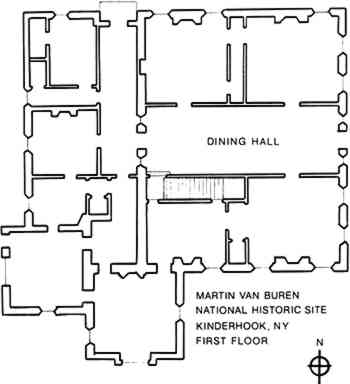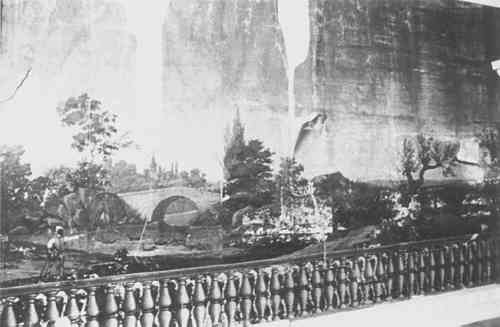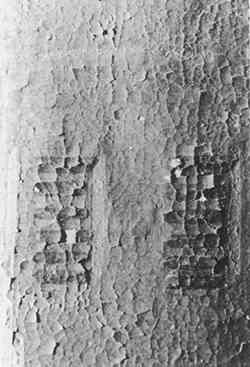THE REMOVAL AND CONSERVATION TREATMENT OF A SCENIC WALLPAPER, PAYSAGE � CHASSES, FROM THE MARTIN VAN BUREN NATIONAL HISTORIC SITEPatricia Hamm, & James Hamm
3 FIRST SURVEYTHE IMMEDIATELY previous owner, who had used the house as an antique shop, had many of the shop's possessions still piled in the first floor rooms, especially the large dining room. Tapestries were hanging on several sections of the wallpaper along with a large array of pictures. There was little light in the room except from the two small windows on the east wall (Fig. 1). The paper support of the wallpaper panels hanging closest to these windows could be seen through the losses of media to have turned brown. The sky of the wallpaper appeared a glossy, dark green rather than the anticipated matte, pale blue because of a heavy, irregular surface varnish which had darkened considerably. Mold staining appeared through the wallpaper but was especially noticeable in the sky.
Water damage could be seen in conjunction with a steam radiator as well as from leaks in the roof. There also seemed to be a kind of mottled water-stain appearing in wide expanses throughout the wallpaper. Numerous tears were present, some corresponding to cracks in the walls. Through the many tears one could observe that part of the rough plaster support was crumbling while other smoother areas had been painted dark blue. Hints of painted decorations were noticeable through the dark blue painted areas. Through the tears one could also see that a liner of wallpaper had been placed irregularly throughout the room. Detachment was a serious problem with perhaps only 50% of the wallpaper remaining securely attached to the wall (Fig. 2).
It appeared from certain tears and mends made during the hanging that the wallpaper was either difficult to handle or hung by inexperienced hangers. Its obvious water-solubility had given the hangers further problems. However, it was finally hung with overlapping edges using a strong flour paste. Insects, mostly silverfish living under the moldings and in the cracks in the walls, caused substantial, characteristic losses, while accretions were limited to the lighter printed areas. The manufacturing trait of placing heavy layers of media upon extremely granular ground layers led to the characteristic cracking, cupping, cleaving, and loss of paint found in many French wallpapers (Figs. 3, 4). This fragile attachment meant that merely touching the surface of the wallpaper would send flakes of paint popping off the support. It appeared that certain green copper pigments were creating a severe embrittlement and darkening of the paper support. These weakened areas were sites for concentrated complex tears.
The following observations made that day led us to recommend that the wallpaper should be removed from the wall for its proper treatment.
At an early symposium on the Martin Van Buren wallpaper held in April 1978, a panel of conservators, architectural analysts and curatorial staff concurred with our recommendations for a removal and reinstallation type of treatment.4 The wall area covered originally by the wallpaper was approximately 815 square feet. With the passage of time, more alterations occurring in the dining hall, and by the time of our survey 680 square feet of scenic and dado wallpaper was left to be considered. With the contract negotiations over, conservation treatment began in the fall of 1978. |



